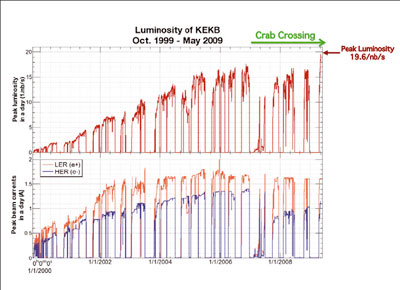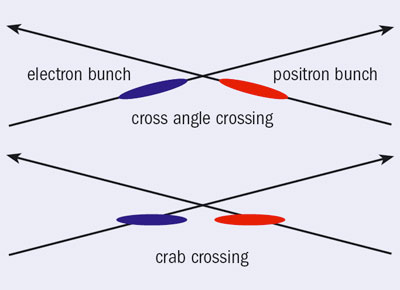A team working at the KEKB electron–positron collider at the KEK laboratory in Japan has broken the machine’s existing world record for luminosity by using new accelerator components called “crab cavities”. The new record is almost a factor of two higher than the original design luminosity of KEK’s B-factory.

Crab cavities in the ring at the KEKB electron–positron collider.
Image credit: KEK.
Until 2007 the electron and positron bunches in the KEKB accelerator beams crossed at an angle of 22 mrad. The crossing angle, a unique feature of the KEKB design, provided an effective separation of the beams after collision, avoiding a high background in the detectors. Its success was evident in the world-beating luminosities that the collider achieved previously. To boost the luminosity further, however, a scheme was required that would allow an effective head-on collision between the beams while still retaining the crossing angle. To accomplish this goal, the team at KEKB designed and built special superconducting RF cavities that kick each beam sideways in the horizontal plane so that the bunches collide head-on at the interaction point. These crab cavities for linear electron–positron colliders were first proposed almost 30 years ago by Robert Palmer and in 1989, K Oide and K Yokoya proposed using them in storage rings. This was followed in around 1992 by the development of designs and prototype models by K Akai as part of collaborative work between KEK and Cornell. Detailed engineering and prototyping by K Hosoyama’s team then took place at KEKB to converge on the current design.

Full-sized cavities were developed after intense discussions and elaboration. The first pair were finally installed at KEKB in January 2007 and detailed commissioning began a month later (CERN Courier September 2007 p8). Recently the team achieved a breakthrough by controlling the behaviour of off-energy beam particles using special skew-sextupole magnets. On 6 May the machine broke the world record, reaching a luminosity of 1.96×1034 cm2/s with the crab cavities. At the same time, the background remained at a good level and data continued to be recorded smoothly in the Belle experiment.

For the future, a B-factory upgrade called SuperKEKB is being planned and designed in Japan. This will build on the experience and hardware developed at KEKB and will increase the luminosity by a factor of 40. The recent breakthrough and the long history of world luminosity records at KEKB suggest that this future machine will achieve its goals. A large international collaboration has been formed to upgrade the Belle detector to observe the collisions at the new high-luminosity facility.








